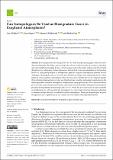Can Isotopologues Be Used as Biosignature Gases in Exoplanet Atmospheres?
Author(s)
Glidden, Ana; Seager, Sara; Petkowski, Janusz J.; Ono, Shuhei
Downloadlife-13-02325-v2.pdf (1.891Mb)
Publisher with Creative Commons License
Publisher with Creative Commons License
Creative Commons Attribution
Terms of use
Metadata
Show full item recordAbstract
Isotopologue ratios are anticipated to be one of the most promising signs of life that can be observed remotely. On Earth, carbon isotopes have been used for decades as evidence of modern and early metabolic processes. In fact, carbon isotopes may be the oldest evidence for life on Earth, though there are alternative geological processes that can lead to the same magnitude of fractionation. However, using isotopologues as biosignature gases in exoplanet atmospheres presents several challenges. Most significantly, we will only have limited knowledge of the underlying abiotic carbon reservoir of an exoplanet. Atmospheric carbon isotope ratios will thus have to be compared against the local interstellar medium or, better yet, their host star. A further substantial complication is the limited precision of remote atmospheric measurements using spectroscopy. The various metabolic processes that cause isotope fractionation cause less fractionation than anticipated measurement precision (biological fractionation is typically 2 to 7%). While this level of precision is easily reachable in the laboratory or with special in situ instruments, it is out of reach of current telescope technology to measure isotope ratios for terrestrial exoplanet atmospheres. Thus, gas isotopologues are poor biosignatures for exoplanets given our current and foreseeable technological limitations.
Date issued
2023-12-11Department
Massachusetts Institute of Technology. Department of Earth, Atmospheric, and Planetary Sciences; MIT Kavli Institute for Astrophysics and Space Research; Massachusetts Institute of Technology. Department of Aeronautics and AstronauticsPublisher
Multidisciplinary Digital Publishing Institute
Citation
Life 13 (12): 2325 (2023)
Version: Final published version